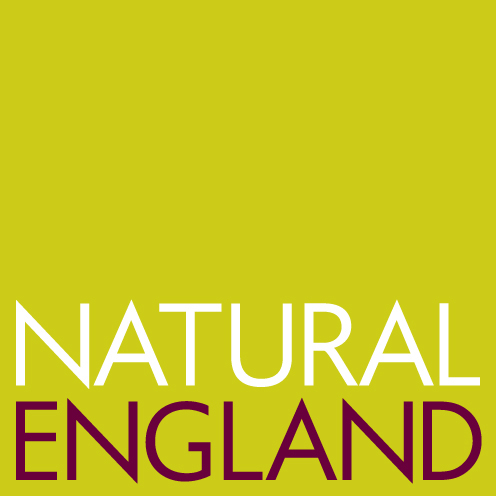The Frith
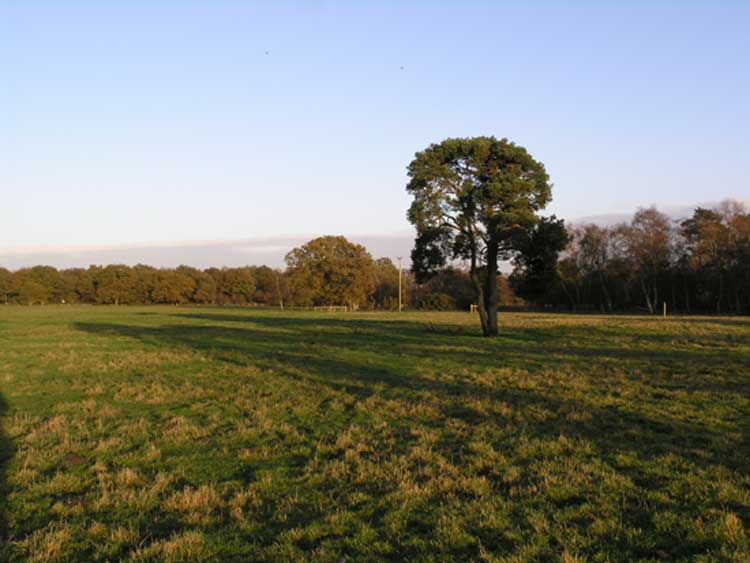
The Frith
Background
The Frith comprises 10.7 ha of rough pasture on the north bank of the River Little Ouse, source of which is at the south-east corner of the field. It forms the first critical link in the chain of sites between Redgrave and Lopham Fen at the head of the Waveney valley and the fenland remnants of the Little Ouse valley. The sources of the two rivers are separated only by the low sandy ridge that carries the B1113 between South Lopham and Redgrave.
Until the end of the 1940s, the predominantly sandy soils of the Frith supported acid grassland and heathland. Local people remember its huge anthills, gorse and heather, and breeding stone curlews. Then, in ca 1950, most of the field was bulldozed and ploughed. Arable crops fared badly on the sandy soils and, after only five years under cultivation, it was progressively reseeded to provide pasture for sheep. Heavy applications of pig slurry during the 1990's not only prevented recovery of its former flora but also encouraged proliferation of stinging nettles.
Conservation
The Little Ouse Headwaters project took on a ten-year lease of the Frith in 2002. The most conspicuous remnant of its formerly rich wildlife was its mature hedges, with many fine oak trees, about half of which had been pollarded. Much of the pasture was dominated by stinging nettles although small pockets of typical acid grassland species, such as harebells and sheep sorrel, remained around the field margins and formed a potential source for recolonisation.
In spring 2003 we were successful in securing major funding for restoring the wildlife and landscape value of both the Frith and Blo'Norton Lows and creating public access. The Heritage Lottery Fund contributed nearly £50,000 towards the restoration project, which was also funded by DEFRA, through the Countryside Stewardship Scheme, and by our own volunteers who provide much of the labour for restoration management tasks.
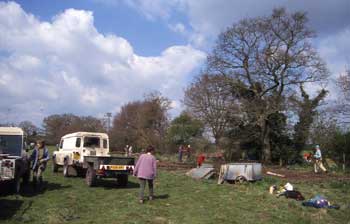
Volunteers clear rubbish from the Frith
We started by clearing the Frith of a large amount of agricultural rubbish, including old fencing, sheds and trailers. Our Heritage Lottery funding enabled us to install new sheep fencing, gates and a water trough so that we could reinstate sheep grazing. This, together with regular topping of the nettles, has already transformed the appearance of the field and is starting to encourage a greater diversity of wildflowers in the sward.
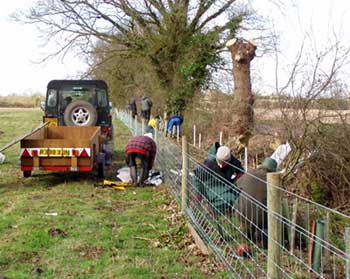
Volunteers planting the new hedge
Expert tree surgeons have re-pollarded some of the ancient pollarded oak trees in the hedgerows. Our volunteers have planted over 400m of new hedge and, with the help of local school children, have also planted new oak and pine trees and clumps of gorse in the open field. The word 'Frith' is Old English for pasture with scattered trees, and we aim to maintain this ancient characteristic of the field. An enduring feature of the Frith is the remains of a pine circle, probably planted by the Victorians as a commemorative circle. We have 'gapped-up' the circle and hope that it will be feature of the field for many years to come.
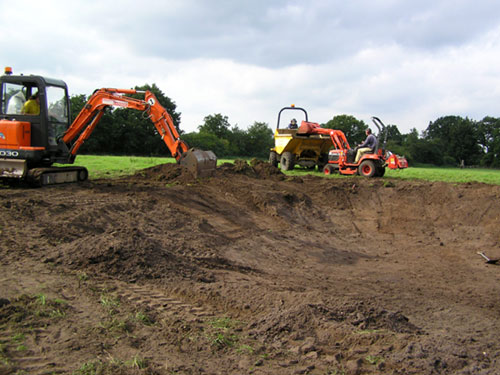
Re-excavation of the field pond, 2007
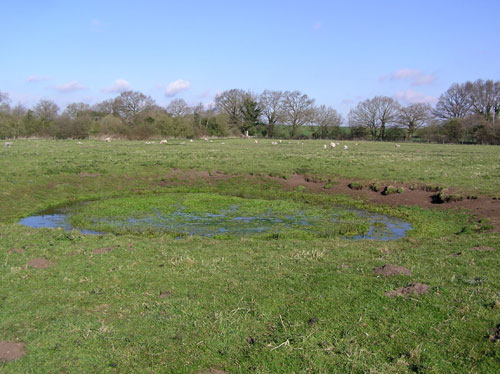
The field pond, 2008
Old aerial photographs show clearly the location of a round field pond that was infilled in the 1960s. The pond was re-excavated in autumn 2006 - clearly in the right place because the mud at the bottom was still smelly! Within weeks of the pond filling, its original flora, including a water crowfoot species, regenerated from buried seed. In winter green sandpipers and snipe feed on the muddy margins.
From 2011 onwards funding for the ongoing restoration work on the Frith has come from Natural England through our Higher Level Stewardship Scheme.
Special Features
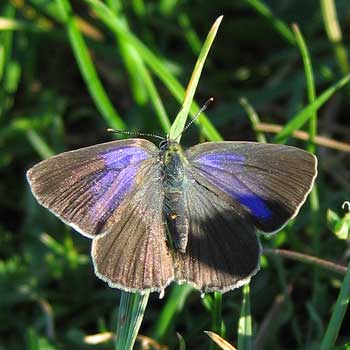
Purple Hairstreak
© A.Shepard
Purple Hairstreak: this tiny, fast flying, butterfly with electric purple wing markings can be seen around the oak trees in the field boundaries during July and August.
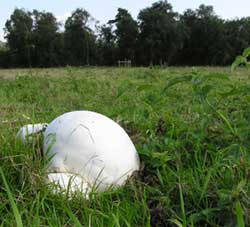
Giant Puffball © A. Rivett
Giant puffballs: in late summer these spectacular fungi are common on the dry, sandy fields around the fens. When fully grown they can be mistaken for sheep!
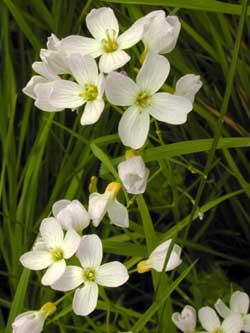
Cuckoo flower
© Malcolm Storey
Cuckoo flower (Cardamine pratensis) was so-called because its flowers appeared with the arrival of the first cuckoos of spring. It is also known as Lady's-smocks or Milkmaids, and used to be a familiar and attractive sight, flowering in drifts of pinky white in wet meadows and fens. Now, rarely seen in such abundance, it grows in the damp, south eastern corner of the Frith.
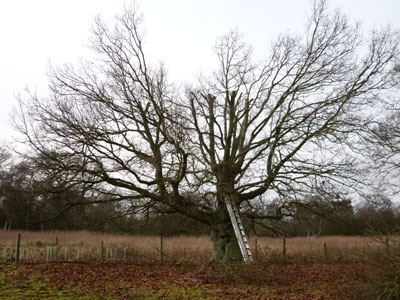
Pollarding, 2009
Pollarded oaks: These ancient trees, traditionally managed by rotational cutting of the branches above grazing height, dominate the hedgerows. The twisted and knotted wood in the coppice 'bole' is full of holes occupied by nesting birds and wild honey bees.
Little owl: This is one of the species to benefit from the holes in the pollarded oak trees. Introduced to the UK during the 19th Century, this small, plump owl spread rapidly over much of lowland England. Unlike many introduced species, Little owls do not appear to have had damaging effects on native species and have become accepted as a familiar and attractive British bird. Over the last thirty years they have declined in many lowland areas, partly as a result of loss of nesting sites in hedgerow trees and old farm buildings.
Access
A new permissive footpath (a DEFRA Countryside Walk) runs round the Frith and links with the Countryside Walk on Blo'Norton Lows. Wide-access kissing gates lead on to the path at the north east corner of the field (access from the Blo'Norton road) and from the B1113, just south of the main field gates. The B1113 entrance allows walkers to cross the road onto the network of permissive paths around Redgrave and Lopham Fen NNR. Map boards just inside the gates together with way-markers show the route of the path.
Please note that dogs must be kept under very close control to protect ground nesting birds and grazing stock.
